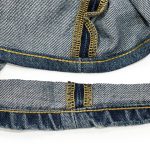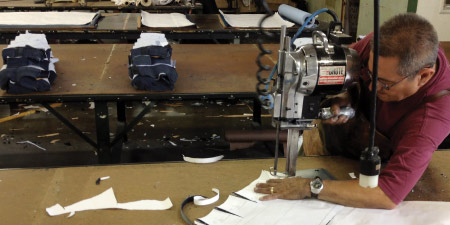
The easiest way to go out of business is to be too big or expand too fast, according to Maurice Malone, the denim designer at Williamsburg Garment Company (WGC). The company has grown by staying small and maximizing its efforts. He advises upcoming American manufacturers to run a smart, small and tight business, built to do business today, not yesterday.
WGC, a one-man company, moved its production from China to the US following former President Barack Obama’s call to bring manufacturing back to the US.
“When our first American-made jeans proved very successful retailing at only a few dollars more than before, I knew the bulk of our customers would gladly pay a little more for American jeans over imported ones. So, I moved all WGC production to the US later that year,” Malone told Fibre2Fashion.
The company plans to expand into knit garments and core wardrobe essentials like t-shirts, sweatshirts, joggers, leggings, and socks this year. It will also be moving most of its production in-house.
Talking about what sets WGC’s denim apart from its competitor’s jeans, he said, “What makes us the same is what sets us apart. We use the same fabrics as most of our American-made brand competitors while having better or equal quality in sewing and construction. I mean, there are only so many ways you can sew a seam and we try to use the best techniques that garner the best result for the design or style. Then we apply a high level of attention to the details.” (KD)
The interview
Q. What inspired you to make jeans in the United States of America?
A few things led me to move my production from China to the United States of America. Working for many years in China, I watched how they used manufacturing to help the growth of their economy. After conversations with my friend who owned the factory in which my clothing was made in China, I realized that if I sacrificed a little individual gain for the greater good, I could be a small part of helping to bring American garment manufacturing back to the country.
So, when President Barack Obama asked companies to bring manufacturing back to the United States of America, I answered the call and named our first American-made jeans Hope Street in honor of the President. It also happens to be a street in Williamsburg.
When our first American-made jeans proved very successful retailing at only a few dollars more than before, I knew the bulk of our customers would gladly pay a little more for American jeans over imported ones. So, I moved all Williamsburg Garment Company (WGC) production to the United States of America later that year.
Q. What is the growth story of WGC?
During the slump in the economy near the end of the Bush years, I could not find investors for the brands I wanted to launch. I was laid off after having a job for a short time and could not find work. I was amazed that someone with my talent, capable of doing any job at a clothing company, could not get hired.
I freelanced to save money to start my own venture. When I started WGC, I wanted to inspire other designers and entrepreneurs and prove that one person using the technology of the day can build and operate a major internationally known brand.
I started the brand going the traditional wholesale, tradeshow route but had my eye on the future, which I believed was direct to consumer via e-commerce. I got the jump by building a powerfully optimized low-cost website that outperformed big expensive websites that focused on looks instead of being found through search optimization. As my direct-to-consumer business grew, I found no time to chase less profitable wholesale to retailers. Today, although I still sell to retail stores, I do it only if buyers contact me. I no longer call on stores or do tradeshows. I just do not have the time.
Q. What are the advantages and disadvantages of running a one-man show?
The disadvantage is with time. I found myself constantly optimizing everything I do, yet there is still only so much time in a day. After nearing the ceiling or topping out, I got help.
The advantage is, that you are in direct, unfiltered contact with consumers, which helps you understand the relationship between your buyers and products. This helped me build a strong base for the company. That is important for growth. Knowing who you are, what you do, and who you are marketing gives you a strong foundation to stand on.
As the designer of a one-man company, people often ask me how I spend most of my time. My answer is, that most of my time is spent working on my website, optimizing, updating, and writing content because the site is the engine that drives my sales. The next large chunk of time is used answering emails, customer service, marketing/online advertising, and shipping. Then comes accounting, general maintenance, and finally, production and design. Optimizing production and design early help me to spend less time on it today with occasional tweaks here and there.
Q. What sets your raw denim jeans apart from those of your competitors’?
What makes us the same is what sets us apart. We use the same fabrics as most of our American-made brand competitors while having better or equal quality in sewing and construction. There are only so many ways you can sew a seam and we try to use the best techniques that garner the best results for the design or style. Then, we apply a high level of attention to detail.
The biggest separator then becomes our price and branding. Many like to claim fit is the deciding factor, but when you make so many fits, it is likely someone has a fit close to yours. So, when you add all the above, we are priced well below most American-made brands that meet us in quality and fit. It is our pricing or the way we lack branding, which is the biggest thing that sets us apart. You can buy jeans made in the United States of America cheaper from Kickstarter-type brands but then you end up waiting months to get the product and quality could be an issue. This is the sweet spot. Many of our customers want moderately priced, great quality, branded American-made jeans without the wait.
The last factor is branding. Most jeans are branded on the outside while we brand ours on the inside. We simply give a classic, clean product without a lot of extras.
Q. What is your take on new blends and colors in a denim industry that has also seen the rise of jeggings?
I would like to see us do more printed fabrics, especially for the summer months.
Q. Which is the one style of jeans that can never go out of date?
With the growth of the Internet and so many people seeing so many things, style is no longer driven by any industry. People all over the world can find what they are into and it is likely that someone offers that. So, I think the days of things going in and out of style are over. That said, the standard straight-leg jean is the most timeless fit when it comes to denim. Fits trend and descend in popularity, but the basic straight has stood the test of time. At WGC, we strive for tradition. The major philosophy behind this brand is to not to give the consumer a reason to say no. We stripped our jeans of everything that may turn people away because clean and classic will last forever.
Q. Which brands in the United States of America provide the most authentic true blue jeans?
Someone who is not knowledgeable about denim would think the oldest brands would be the obvious choice. They do not realise that these brands are now mainly producing jeans not made in the United States of America. Obviously, we are a bit biased, but WGC is one of the few brands that offers modern, wearable jeans of top quality with fits that appeal to all consumers.
Q. How has the market for jeans evolved in the United States of America? What are your views on the current market?
Denim remains an essential part of people’s wardrobe. Leggings have taken a good portion of denim away in the women’s market while joggers have done the same to a lesser effect in the men’s market. However, more men find clean, dark denim more suitable for business casual wear. As far as style, I don’t see skinny going anywhere but I do see more people opting for loose fits as an alternative look.
Q. With Made in USA back in trend, what is the growth story you envisage?
We plan to be a top maker of US denim in the world, the brand everyone thinks of when thinking of American denim. We have grown by staying small and maximising our efforts. The easiest way to go out of business is to be too big or expand too fast.
Q. At what rate is the jeans market growing in the United States of America? What are your expectations from it for the next two years?
I am not a researcher to give you market numbers but I can give historical facts. Denim will be strong in the foreseeable future, just like it has been in the past.
Q. From where do you source raw material?
Our denim is sourced from three main suppliers. About 92 per cent is from Cone denim which is made in the United States of America, about five per cent from Kuroki while three per cent is Kaihara denim, made in Japan.
Q. What is your manufacturing capacity?
Our factory is just starting. Our goal is to produce the WGC collection and start small with other brands to give us time to learn, perfect and optimise our production process.
Q. What are your plans for the company this year?
This year, we are expanding into knit garments and core wardrobe essentials like T-shirts, sweatshirts, joggers, leggings and socks. We are moving most production in-house. Too many times, suppliers we relied on fell way behind with delivery timelines, which makes us look bad to our customers. Our slogan is: We have a clear, focused vision: To be the world’s favourite American Denim Brand.
That cannot be achieved with late deliveries. We now have our own manufacturing arm. We intend to grow and market the new manufacturing company the way it should be done in today’s market.
Q. How much do you invest in R&D every year?
We do not waste much money on R&D. Timelines are short and experimenting can be expensive. We have ideas and take them into production, starting small and safe with new products.
Q. How has the performance of your company been this fiscal? At what percentage are you expecting to grow in the next fiscal?
We have seen a small percentage growth each year. I believe the company has nearly topped out in numbers it can reach as a one-man company, so I have taken on help this year. Our growth now is only limited by our credit limits. In the current banking situation, we have seen credit lines grow slower than anticipated, so part of my focus this year will be to look for financial institutions that will work with our company to help us maximize our potential.
Q. Any suggestions for those planning to manufacture and sell items in the United States of America?
Run a smart, small and tight business. Start a business built to do business today, not yesterday.










